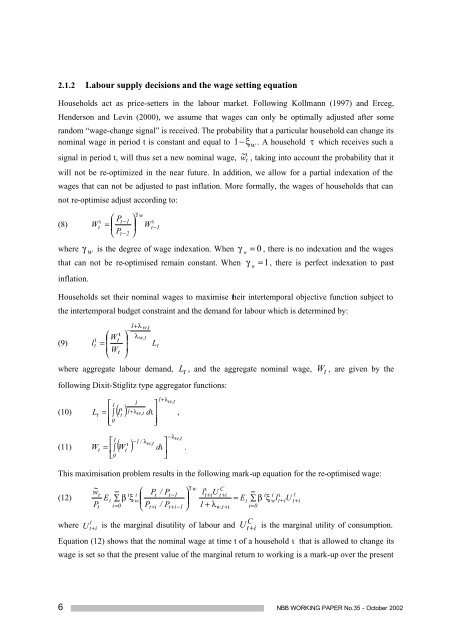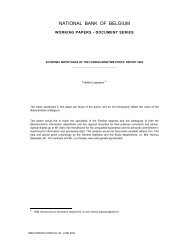2.1.2 Labour supply decisions and <strong>the</strong> wage setting equationHouseholds act as price-setters in <strong>the</strong> labour market. Following Kollmann (1997) and Erceg,Henderson and Levin (2000), we assume that wages can only be optimally adjusted after somerandom “wage-change signal” is received. The probability that a particular household can change itsnominal wage in period t is constant and equal to 1 −ξ w . A household τ which receives such aιsignal in period t, will thus set a new nominal wage, w ~ t , taking into account <strong>the</strong> probability that itwill not be re-optimized in <strong>the</strong> near future. In addition, we allow for a partial indexation <strong>of</strong> <strong>the</strong>wages that can not be adjusted to past inflation. More formally, <strong>the</strong> wages <strong>of</strong> households that cannot re-optimise adjust according to:(8)Wιt⎛ P=⎜⎝ Pt−1t−2⎞⎟ ⎠γ wWιt−1where γ w is <strong>the</strong> degree <strong>of</strong> wage indexation. When γw= 0 , <strong>the</strong>re is no indexation and <strong>the</strong> wagesthat can not be re-optimised remain constant. When γ = 1, <strong>the</strong>re is perfect indexation to pastinflation.Households set <strong>the</strong>ir nominal wages to maximise <strong>the</strong>ir intertemporal objective function subject to<strong>the</strong> intertemporal budget constraint and <strong>the</strong> demand for labour which is determined by:1+λ w t,−⎛ ιW ⎞ λι t w,t(9) l ⎟t = ⎜Lt⎜ Wt⎟⎝ ⎠where aggregate labour demand,following Dixit-Stiglitz type aggregator functions:⎡1ι(10) L ⎢∫( l )⎡1ι(11) W ∫ ( W )tt1+λw,t1 ⎤= 1+λt w,t dι⎥,⎢⎣0 ⎥⎦−λw,t−1 / λw,t⎤= ⎢ t dι⎥.⎣0⎦L t , and <strong>the</strong> aggregate nominal wage,wW t , are given by <strong>the</strong>This maximisation problem results in <strong>the</strong> following mark-up equation for <strong>the</strong> re-optimised wage:∞w Cw ~γ ι⎛(12) ∑⎟ ⎞∞t i i P⎜t / Pt−1l t + i U t + iiEtβ ξ w= Et∑ β ξPti= 0 ⎝ Pt+ i / Pt+ i−1⎠ 1 + λw,t+ i i=0wherelU t+ iis <strong>the</strong> marginal disutility <strong>of</strong> labour andi ιwlt+iUlt+iCU t+i is <strong>the</strong> marginal utility <strong>of</strong> consumption.Equation (12) shows that <strong>the</strong> nominal wage at time t <strong>of</strong> a household ι that is allowed to change itswage is set so that <strong>the</strong> present value <strong>of</strong> <strong>the</strong> marginal return to working is a mark-up over <strong>the</strong> present6 NBB WORKING PAPER No.35 - October 2002
value <strong>of</strong> marginal cost (<strong>the</strong> subjective cost <strong>of</strong> working). 10 When wages are perfectly flexible( ξ w = 0 ), <strong>the</strong> real wage will be a mark-up (equal to 1+ λ w, t ) over <strong>the</strong> current ratio <strong>of</strong> <strong>the</strong> marginaldisutility <strong>of</strong> labour and <strong>the</strong> marginal utility <strong>of</strong> an additional unit <strong>of</strong> consumption. We assume thatwshocks to <strong>the</strong> wage mark-up, λ w, t = λw+ ηt, are IID-Normal around a constant.Given equation (11), <strong>the</strong> law <strong>of</strong> motion <strong>of</strong> <strong>the</strong> aggregate wage index is given by:γ−1/λww t,⎛1 /P ⎞− λt 11/t w t 1ww ~ λξ⎜ ⎛ − ⎞ ⎟−⎜ −⎜ξ tP⎟⎟t−2(13) ( W )w,t= W+ (1 − )( )w, t2.1.3 Investment and capital accumulation⎝⎝⎠⎠Finally, households own <strong>the</strong> capital stock, a homogenous factor <strong>of</strong> production, which <strong>the</strong>y rent outkto <strong>the</strong> firm-producers <strong>of</strong> intermediate goods at a given rental rate <strong>of</strong> r t . They can increase <strong>the</strong>supply <strong>of</strong> rental services from capital ei<strong>the</strong>r by investing in additional capital ( I t ), which takes oneperiod to be installed or by changing <strong>the</strong> utilisation rate <strong>of</strong> already installed capital ( z t ). Bothactions are costly in terms <strong>of</strong> foregone consumption (see <strong>the</strong> intertemporal budget constraint (4) and(5)). 11Households choose <strong>the</strong> capital stock, investment and <strong>the</strong> utilisation rate in order to maximise <strong>the</strong>irintertemporal objective function subject to <strong>the</strong> intertemporal budget constraint and <strong>the</strong> capitalaccumulation equation which is given by:I(14) Kt= Kt−1 [ 1−] + [ 1−S( εtI t / I t −1)] I tτ ,where I t is gross investment, τ is <strong>the</strong> depreciation rate and <strong>the</strong> adjustment cost function S (.) is apositive function <strong>of</strong> changes in investment. 12 S (.) equals zero in steady state with a constantinvestment level. In addition, we assume that <strong>the</strong> first derivative also equals zero around<strong>equilibrium</strong>, so that <strong>the</strong> adjustment costs will only depend on <strong>the</strong> second-order derivative as in CEE(2001). We also introduce a shock to <strong>the</strong> investment cost function, which is assumed to follow aI I Ifirst-order autoregressive process with an IID-Normal error term: ε t = ρIεt−1 + ηt. 1310111213Standard RBC <strong>model</strong>s typically assume an infinite supply elasticity <strong>of</strong> labour in order to obtain realistic business cycleproperties for <strong>the</strong> behaviour <strong>of</strong> real wages and employment. <strong>An</strong> infinite supply elasticity limits <strong>the</strong> increase inmarginal costs and prices following an expansion <strong>of</strong> output in a <strong>model</strong> with sticky prices, which helps to generate realpersistence <strong>of</strong> monetary shocks. The introduction <strong>of</strong> nominal-wage rigidity in this <strong>model</strong> makes <strong>the</strong> simulationoutcomes less dependent on this assumption, as wages and <strong>the</strong> marginal cost become less sensitive to output shocks, atleast over <strong>the</strong> short term.This specification <strong>of</strong> <strong>the</strong> costs is preferable above a specification with costs in terms <strong>of</strong> a higher depreciation rate (seeKing and Rebelo, 2000; or Greenwood, Hercowitz, and Huffman, 1988; Dejong, Ingram and Whiteman, 2000)because <strong>the</strong> costs are expressed in terms <strong>of</strong> consumption goods and not in terms <strong>of</strong> capital goods. This formulationlimits fur<strong>the</strong>r <strong>the</strong> increase in marginal cost <strong>of</strong> an output expansion (See CEE, 2001).See CEE (2001).See, Keen (2001) for a recent DSGE <strong>model</strong> with sticky prices in which one <strong>of</strong> <strong>the</strong> shocks comes from changes in costs<strong>of</strong> adjusting investment.NBB WORKING PAPER No. 35 - October 2002 7
















